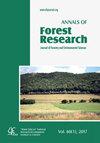特兰西瓦尼亚最大的城郊森林使用中的性别不平等
IF 2.9
3区 农林科学
Q2 FORESTRY
引用次数: 1
摘要
城市绿地(公共花园、公园、城市和城郊森林)为娱乐活动提供了多用途的机会和空间,在2019冠状病毒病大流行期间为支持居民的身心健康发挥了关键作用,是少数允许进行户外和社交活动的场所之一。这项研究是在Brașov市(也被称为喀琅施塔得,其德国名称)进行的,这是罗马尼亚第二大都市区,被特兰西瓦尼亚的大片城市周边森林所包围。Brașov城市只有5.62平方米的城市绿地/居民,是全国最低的城市之一,所以大面积的城郊森林地区的存在对当地人和游客来说是非常有价值的。由于了解游客的期望和看法是支持决策者和确保适当管理这些森林的关键因素,Brașov的森林管理员(喀琅施塔得地方公共林区- RPLPK)决定调查居民通常如何与城市周边森林互动,并确定提高森林提供社会和娱乐服务能力的机会。数据是在2021年初通过计算机辅助网络访谈(CAWI)对314名受访者进行的,此时距离全国实施大流行封锁整整一年。分析参与者的回答,一个令人惊讶的事实变得明显:城市边缘森林的使用并不平等,女性比男性更不能进入这些绿色自然空间,因此,吸收城市边缘森林提供的好处。本文章由计算机程序翻译,如有差异,请以英文原文为准。
Gender inequalities in Transylvania's largest peri-urban forest usage
Urban green spaces (public gardens, parks, urban and peri-urban forests) offer multiple-use opportunities and spaces for recreational activities and played a key role in supporting mental and physical health of dwellers during covid-19 pandemic, being ones of few places where outdoor and social activities where allowed. This study was conducted in Brașov city (also known as Kronstadt, by its German name), the second largest metropolitan area of Romania and surrounded by a significant area of peri-urban forests in Transylvania. Brașov city own just 5.62 sqm of urban green space/inhabitant, one of the lowest in the country, so the presence of a large peri-urban forest area become very valuable for locals and tourists visiting the area. Due to its importance and because understanding visitors' expectations and perceptions is a key element to support decision-makers and ensure proper management of these forests, the Brașov’s forests administrator (Kronstadt Local Public Forest District – RPLPK) decided to investigate how dwellers generally interact with the peri-urban forests and to identify opportunities for improving the capacity of forests in providing social and recreational services. Data were collected through the administration of CAWI (computer assisted web interview) to 314 respondents at beginning of 2021, at exactly one year distance after the pandemic lockdown was imposed all around the country. Analyzing the participants responses, a surprising fact become evident: the use of peri-urban forest is not gender equal, women being less able than men to access these green natural spaces and, therefore, to uptake the benefits provided by the peri-urban forests.
求助全文
通过发布文献求助,成功后即可免费获取论文全文。
去求助
来源期刊

Annals of Forest Research
FORESTRY-
CiteScore
2.20
自引率
11.10%
发文量
11
审稿时长
12 weeks
期刊介绍:
Annals of Forest Research is a semestrial open access journal, which publishes research articles, research notes and critical review papers, exclusively in English, on topics dealing with forestry and environmental sciences. The journal promotes high scientific level articles, by following international editorial conventions and by applying a peer-review selection process.
 求助内容:
求助内容: 应助结果提醒方式:
应助结果提醒方式:


